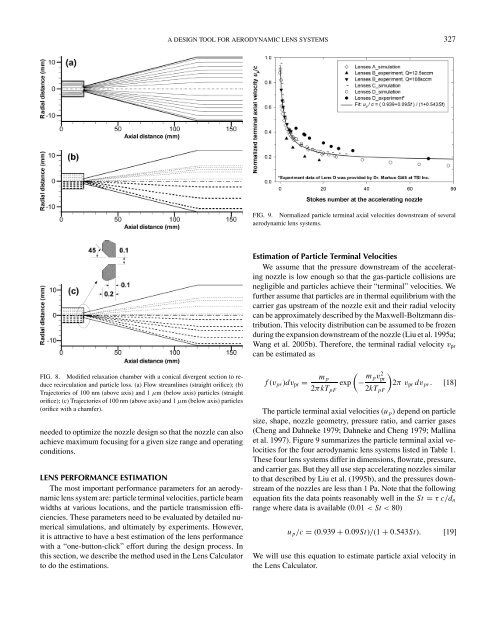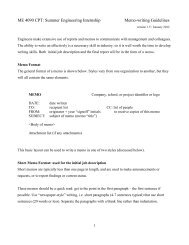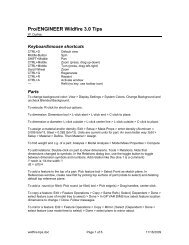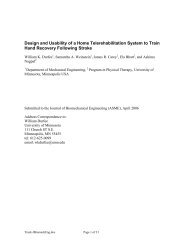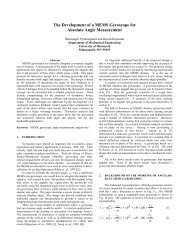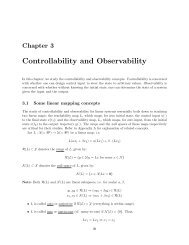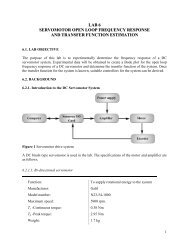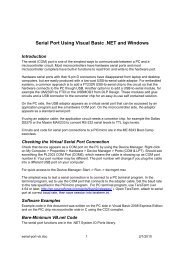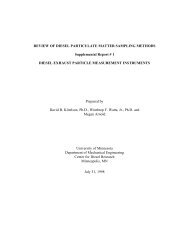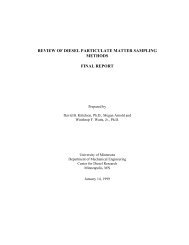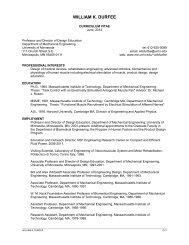A Design Tool for Aerodynamic Lens Systems - Department of ...
A Design Tool for Aerodynamic Lens Systems - Department of ...
A Design Tool for Aerodynamic Lens Systems - Department of ...
Create successful ePaper yourself
Turn your PDF publications into a flip-book with our unique Google optimized e-Paper software.
FIG. 8. Modified relaxation chamber with a conical divergent section to reduce<br />
recirculation and particle loss. (a) Flow streamlines (straight orifice); (b)<br />
Trajectories <strong>of</strong> 100 nm (above axis) and 1 µm (below axis) particles (straight<br />
orifice); (c) Trajectories <strong>of</strong> 100 nm (above axis) and 1 µm (below axis) particles<br />
(orifice with a chamfer).<br />
needed to optimize the nozzle design so that the nozzle can also<br />
achieve maximum focusing <strong>for</strong> a given size range and operating<br />
conditions.<br />
LENS PERFORMANCE ESTIMATION<br />
The most important per<strong>for</strong>mance parameters <strong>for</strong> an aerodynamic<br />
lens system are: particle terminal velocities, particle beam<br />
widths at various locations, and the particle transmission efficiencies.<br />
These parameters need to be evaluated by detailed numerical<br />
simulations, and ultimately by experiments. However,<br />
it is attractive to have a best estimation <strong>of</strong> the lens per<strong>for</strong>mance<br />
with a “one-button-click” ef<strong>for</strong>t during the design process. In<br />
this section, we describe the method used in the <strong>Lens</strong> Calculator<br />
to do the estimations.<br />
A DESIGN TOOL FOR AERODYNAMIC LENS SYSTEMS 327<br />
FIG. 9. Normalized particle terminal axial velocities downstream <strong>of</strong> several<br />
aerodynamic lens systems.<br />
Estimation <strong>of</strong> Particle Terminal Velocities<br />
We assume that the pressure downstream <strong>of</strong> the accelerating<br />
nozzle is low enough so that the gas-particle collisions are<br />
negligible and particles achieve their “terminal” velocities. We<br />
further assume that particles are in thermal equilibrium with the<br />
carrier gas upstream <strong>of</strong> the nozzle exit and their radial velocity<br />
can be approximately described by the Maxwell-Boltzmann distribution.<br />
This velocity distribution can be assumed to be frozen<br />
during the expansion downstream <strong>of</strong> the nozzle (Liu et al. 1995a;<br />
Wang et al. 2005b). There<strong>for</strong>e, the terminal radial velocity vpr<br />
can be estimated as<br />
f (vpr)dvpr = m �<br />
p<br />
exp −<br />
2πkTpF<br />
m pv2 �<br />
pr<br />
2π vpr dvpr. [18]<br />
2kTpF<br />
The particle terminal axial velocities (u p) depend on particle<br />
size, shape, nozzle geometry, pressure ratio, and carrier gases<br />
(Cheng and Dahneke 1979; Dahneke and Cheng 1979; Mallina<br />
et al. 1997). Figure 9 summarizes the particle terminal axial velocities<br />
<strong>for</strong> the four aerodynamic lens systems listed in Table 1.<br />
These four lens systems differ in dimensions, flowrate, pressure,<br />
and carrier gas. But they all use step accelerating nozzles similar<br />
to that described by Liu et al. (1995b), and the pressures downstream<br />
<strong>of</strong> the nozzles are less than 1 Pa. Note that the following<br />
equation fits the data points reasonably well in the St = τ c/dn<br />
range where data is available (0.01 < St < 80)<br />
u p/c = (0.939 + 0.09St)/(1 + 0.543St). [19]<br />
We will use this equation to estimate particle axial velocity in<br />
the <strong>Lens</strong> Calculator.


